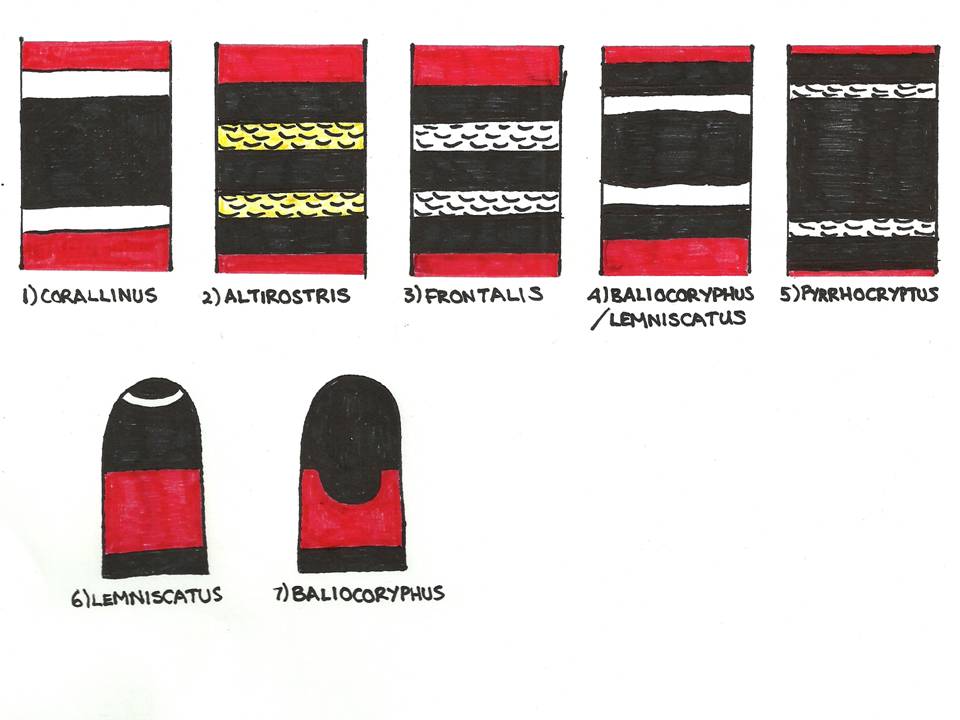
Designed by Paul Smith 2006. This website is copyrighted by law.
Material contained herewith may not be used without the prior written permission of FAUNA Paraguay.
FAMILY ELAPIDAE - ELAPIDS (ELAPID SNAKES)
Six Paraguayan species in this family all classified in the genus Micrurus. This family includes some of the world´s most venomous species such as the cobras, sea snakes and coral snakes. Though the neurotoxic venom which they possess is more deadly to humans than the haemotoxic venom of the Viperidae, the Paraguayan species in this family are responsible for far less human fatalities than are the Vipers on account of their small size and fixed, rear-facing fangs being located anteriorly in the mouth, necessitating an extremely precise and deep bite to envenomate a human being. All Paraguayan Elapids belong to the subfamily Elapinae.
The maxilla and premaxilla do not come into contact. The maxilla is shortened with an anterior maxillary tooth grooved or hollow and forming a short, fixed, envenomating fang. The premaxilla is toothless and the palatines are movable. Members of this family have adapted to a variety of lifestyles, being terrestrial, fossorial, arboreal and some species even aquatic or marine. Oviparous.
SUBFAMILY ELAPINAE - CORAL SNAKES
All Paraguayan members of this subfamily belong to the Tribe Elapini, the American and North Asian Coral Snakes. They are typified by their banded red, black and yellow or white colouration. The common pattern of three black rings separated by white or yellow, shown by most Paraguayan Corals, is known as a "triad". Many inoffensive species take advantage of the distinctive colouration of this group through mimicy, though most lack the "triad" pattern.
Stylised images of typical dorsal patterns are provided for each species at the bottom of this page, but it should be noted that these species are extremely variable and identification should be made with care.
Key to Adults of Paraguayan Coral Snakes
1a No triad pattern. Single black band bordered by thin white band. "Red to yellow" order. (Fig 1) Atlantic Forest........................................................................................................................................Micrurus corallinus
1b Triad pattern. Two yellow or white bands bordered by black and separated by a central black band. "Red to black" order.......................................................................................................................................................2
2a Head (frontal, supraoculars and parietals) completely or mostly black. White rings........................................3
2b Head with reduction of black on parietals. Black snout and chin heavily marked with black. Yellow or creamy-white rings shorter than the external black ones. Middle black ring sometimes longer than the external ones. (Fig 2) Tendency towards melanism. 13 to 18 triads. Southern and eastern Oriental region.......................................................................................................................................... Micrurus altirostris
3a Middle black triad ring longer than the external ones. External black rings longer than white rings............... 4
3b Subequal black rings. Snout usually black; white rings shorter or the same length as the external black rings, (Fig 3). 10 to 15 triads. If middle black ring is longer than external ones, white rings are also longer than external ones. Northern Oriental region....................................................................................................Micrurus frontalis
4a Immaculate white rings (Fig 4); 9 to 16 triads .......................................................................................... 5
4b Black-tipped white rings (Fig 5); 6 to 11 total triads. Northern (dry) Chaco and Pantanal region......................................................................................................................................Micrurus pyrrhocryptus
5a Little or no white on internasals. Anterior edge of red collar behind black head deeply convex (horseshoe-shaped) so that collar appears to creep up the side of the head. (Fig 7) Humid Chaco and Ñeembucú region.................................................................................................................................... Micrurus baliocoryphus
5b White band across internasals and tip of snout black. Anterior edge of red collar behind black head straight, so that it resembles and even band in dorsal view. (Fig 6) Amambay region.......................... Micrurus lemniscatus
REFERENCES
Caccialli P 2010 - Guía para la Identificación de 60 Serpientes del Paraguay - Guyra Paraguay, Asunción.
da Silva N, Sites JW 1999 - Revision of the Micrurus frontalis Complex (Serpentes: Elapidae) - Herpetological Monographs 13: p142-194.
Fouquette MJ (unpublished) - Synopsis of Recent Reptiles to Genus - Arizona University
Whitfield P Ed.1984 - Longman Illustrated Animal Encyclopedia - Guild Publishing, London.




